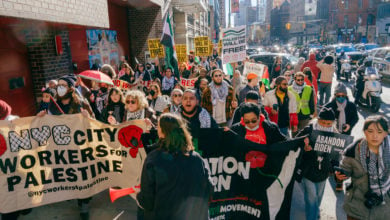 Photo: Bill Hackwell |
Brooks’ thesis is half true—the rich are getting richer throughout the world. In 2004, the world’s largest 500 corporations posted their highest profits and revenues ever—$731.2 billion in profits and $14.9 trillion in revenue. (Fortune.com, July 12, 2004) But his cheery portrait of global capitalism ignores what life is like for those who do not own banks, corporations and factories.
Brooks neglects to mention what globalization means for billions of exploited workers in the United States and around the world who must sell their labor to fuel production. Workers are not benefiting from the massive profits reaped by Wall Street and big business. On the contrary, they are getting poorer.
The world’s richest 1 percent receive as much income as the poorest 57 percent combined. In 1999-2000, 2.8 billion people lived on less than $2 a day and 840 million went undernourished. More than 2.4 billion did not have access to sanitation services. One in six children of grade school age were not in school. Almost 50 percent of the global nonagricultural labor force was either unemployed or underemployed. (United Nations, “Human Development Report,” 2002)
As profits surge, employed and unemployed workers in capitalist countries face unparalleled cuts in wages and benefits. Workers are losing unions and affordable healthcare, housing and education. Unemployment and social inequality are rising.
These are fundamental features of capitalism. Karl Marx pointed to this trend in 1867, writing in Capital, “Accumulation of wealth at one pole is, therefore, at the same time accumulation of misery … at the opposite pole.” The rich get richer as the poor get poorer.
 Workers at Levi Strauss factory in El Paso, Texas prior to closing of the company’s last U.S. plant in 2002. Photo: Jack Kurtz |
The U.S. is the richest industrial country in the world today. It is an imperialist superpower bent on expanding its markets and plundering nations with lesser developed economies or desirable resources. This is clear from Iraq to Mexico. United States capitalists preach free market policies. They are the main purveyors of globalization.
We often hear about the ravages of globalization affecting oppressed countries like India, South Africa and Argentina. Dire poverty, homelessness and malnutrition plague these nations. We hear less about what these policies mean for workers in the U.S.
Since the early 1970s, the quality and security of U.S. workers’ jobs have steadily eroded. Deregulation of industry, sweeping privatization of public-sector jobs, social spending cuts, reactionary labor laws and free-trade deals have all meant a steady decline for workers’ standard of living.
These policies together have given owners the economic leverage to force U.S. workers to toil longer and harder for less. Wages and family income have dropped sharply for more than two decades. The real weekly earnings (in 1992 dollars) of nonsupervisory workers fell from $315 in 1973 to $264 in 1989. It rose slightly in the 1990s to $271 in 1999—still lower in real terms than the average wage in 1962. (“Real World Macro,” Dollars & Sense, 2001)
Yet, workers’ ability to produce is up. In 2004, workers in this country produced $11 trillion worth of goods and services. (Bureau of Economic Analysis, 2004) The total value of goods and services produced in a year is known as a country’s gross domestic product. The U.S. GDP is the highest of any country in the world and $11 trillion is the most it has ever been. If workers are producing more, why aren’t they getting more in return?
The gains of higher worker productivity are flowing directly to the top. From 2000 to 2003, income shifted dramatically from labor compensation (wages) to capital income (profits for owners), so the benefits of higher productivity went completely to the owners. “These shifts from labor to capital are large, comparable in size to the loss of wages for the typical worker due to factors such as the shift to services, globalization, the drop in unionization or any of the other prominent causes of growing wage inequality.” (“The State of Working America,” Economic Policy Institute, 2004)
This is evident in the numbers. Workers earning very low wages represented 9.8 percent of the workforce in 2000, which is 4.9 percent more than in 1979. And 25 percent of U.S. workers earn poverty-level wages. In sharp contrast, CEO’s incomes are soaring. A CEOs’ salary is, on average, more than 301 times a worker’s salary at the same company. (United for a Fair Economy, April 14, 2004)
Racism and sexism also figure prominently in the analysis of declining or stagnant wages. The same figures reveal that around 30 percent of Black workers earned poverty wages in 2003. For Latino workers, the number was a staggering 39.8 percent. Women are more likely to earn poverty wages than men.
The only wage increases in family income in recent decades have come from women’s additional work in families where men also hold jobs—two-income households. This is particularly true for families in the poorest 20 percent of the population. As a result, parents have less time to be with their children. People have less time to spend with their partners.
High tech and the service sector
Since the 1970s there has been a massive and general shift from relatively high-skilled, high-paid jobs to lower-skilled, low-paid service industry jobs. This change was spurred by the introduction of high technology—specifically computers—into the workforce. Technology made it easier for fewer workers to do more work, thereby increasing overall productivity.
The unbridled growth of Wal-Mart and other low-wage employers is a by-product of the high-tech revolution. Wal-Mart is both the world’s largest corporation and its largest private employer, with 1.2 million employees. Service corporations like Wal-Mart force down wages and working conditions of entire communities.
Another result of this economic shift is a fundamental change in the character of the working class. The lower-skilled, lower-paid workers are disproportionately Black, Latino, Asian and Arab, as well as women and undocumented workers. These groups have become preponderant in the general workforce of the U.S. as the number of more traditionally privileged workers has fallen.
The number of jobs requiring special skills has fallen as well. In the shift to a service economy, high-paid manufacturing jobs have disappeared most rapidly. The great majority have fled the U.S. and relocated where labor is cheaper.
Outsourcing jobs to poor countries with little industrial development is standard practice in the global capitalist economy. It maximizes the profits of transnational corporations. But outsourcing harms both U.S. workers as well as those living where the corporation eventually settles. U.S. workers lose jobs while foreign workers get super-exploited.
In the U.S., many of these manufacturing jobs were unionized, like auto and steel. They offered decent wages and benefits. Manufacturing was once responsible for the bulk of mass production in the U.S. This is no longer the case.
Between January 2001 and May 2003, U.S. manufacturing jobs declined by 13.3 percent, with an even steeper decline thereafter. Every state and Washington, D.C. lost manufacturing jobs. New Hampshire fared worst, losing 21 percent during this period. (Washington Times, July 25, 2003)
Black workers bore the brunt of this manufacturing flight. Many Black workers held skilled and better paying jobs in cities like Detroit or Gary, Indiana. Both of these cities are now largely de-industrialized. Huge numbers of Black workers are now unemployed.
 Photo: Bill Hackwell |
Unemployment factors into the overall declining standard of living in the U.S. The present unemployment figure is 5.5 percent. This number, however, is deceiving. The racism inherent in the capitalist system is unaccounted for. Breaking down unemployment levels by race tells a different story.
In October 2004, unemployment was 4.7 percent for white workers and 10.7 percent for Black workers. At the height of the economic boom in 2000, Black unemployment was still 7.6 percent, double the 3.5 percent figure for whites. (Bureau of Labor Statistics, 2004)
More shockingly, at least 2.5 million workers—mostly African Americans and other people of color—are “missing” from the workforce. In other words, these workers should be in the workforce but are not because they have given up looking for jobs. If these workers were included in official Bureau of Labor Statistics figures, the jobless rate in October 2004 would have been more than 7.2 percent, rather than 5.5.
The U.S. government says that the country is in an economic recovery and jobs are being created by the thousands. Numerically, there is a net increase in jobs. But what type of jobs? And who gets them? The new jobs created typically pay less and offer fewer benefits than the ones that were eliminated. Most of the jobs created are low-paying, while high-paying jobs continue to decline.
Thirteen percent of jobs created in the past several months have been temporary or part-time jobs, according to the Bureau of Labor Statistics. These jobs pay 10-15 percent less than full time jobs and usually do not include healthcare or other benefits. The Economic Policy Institute, a liberal U.S. think tank, reports that around 31 percent of women and 23 percent of men work temporary or part-time jobs or on a contract basis.
Inequality rules
The overall impact of declining wages and unemployment is a dramatic increase in social inequality. In the U.S., there is a highly unequal distribution of wealth by class.
The wealthiest 1 percent of people controls more than one-third of the country’s wealth. The bottom 80 percent—the working class—have only 16 percent. Even more outrageous, the richest 20 percent hold 84.4 percent of all wealth, while the poorest 20 percent are in debt—they owe more than they own, according to the 2004 “State of Working America.” The burden of debt is sure to increase in the coming period as the specter of inflation haunts workers.
Inequality statistics also highlight the reality of racism in the U.S. The average Black family owns only 14 percent of what the average white family owns.
Social inequality under capitalism not only harms workers in the U.S. It also hurts workers in the rest of the world. The worldwide income gap between the richest 20 percent and the poorest 20 percent rose from 30:1 in 1960, to 60:1 in 1990, and to 74:1 in 1999 and is projected to reach 100:1 in 2015, according to the 2002 United Nations Human Development Report.
Class-wide solidarity
Declining living standards and inequality will not disappear overnight. They are built into the capitalist system. Capitalism’s sole motive is maximizing profit for the handful of owners, not meeting human needs. It is unable to provide a decent living for the working class. It breeds misery for workers at home and destroys countries and cultures abroad.
Capitalism also creates irreconcilable class contradictions. In so doing it creates its own “grave diggers”—the multinational working class.
The change in the social composition of the working class lays the objective basis for a movement of the entire U.S. working class. Black, Latino, white, Asian and Arab workers all toil together in the U.S. They are women and men, gay and straight.
Bush and the right wing are currently trying to push workers’ living standards farther down than they are today. Building consciousness and class unity is the only way to counter this assault.
Forged together, a powerful, multinational movement of the working class can fight against capitalist exploitation both at home and abroad. It is no longer just desirable. It is necessary.






